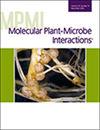求助PDF
{"title":"Distinct Virulence Mechanisms of <i>Burkholderia gladioli</i> in Onion Foliar and Bulb Scale Tissues.","authors":"Sujan Paudel, Yaritza Franco, Mei Zhao, Bhabesh Dutta, Brian H Kvitko","doi":"10.1094/MPMI-10-24-0129-R","DOIUrl":null,"url":null,"abstract":"<p><p>Slippery skin of onion caused by <i>Burkholderia gladioli</i> pv. <i>alliicola</i> (Bga) is a common bacterial disease reported from onion-growing regions around the world. Despite the increasing attention in recent years, our understanding of the virulence mechanisms of this pathogen remains limited. In this study, we characterized the predicted genetic determinants of virulence in Bga strain 20GA0385 using a reverse genetics approach. Using the closely related rice pathogen <i>B. glumae</i> as a reference, comparative genomics analysis was performed to identify Bga candidate virulence factors and regulators. Marked and unmarked deletion mutants were generated using allelic exchange, and the mutants were functionally validated using in vitro and in vivo assays. The role of mutants in pathogenic phenotypes was analyzed using onion foliar/seedling necrosis assays, the red scale necrosis assay, and in planta bacterial population counts. The phytotoxin toxoflavin was a major contributor to foliar necrosis and bacterial populations, whereas the type II and type III secretion systems (T2SS/T3SS) were dispensable for foliar symptoms. In onion scale tissue, the T2SS single mutant <i>gspC</i> and its double and triple mutant derivatives all contributed to scale lesion area. Neither the lipocyclopeptide icosalide, toxoflavin, nor T3SS was required for scale symptoms. Our results suggest that the quorum sensing <i>tofIMR</i> system in Bga regulates toxoflavin, T2SS, and T3SS, contributing to onion symptom production. We show that different virulence factors contribute to onion tissue-specific virulence patterns in Bga and that decreases in scale symptoms often do not result in decreased Bga populations in onion tissue. [Formula: see text] Copyright © 2025 The Author(s). This is an open access article distributed under the CC BY-NC-ND 4.0 International license.</p>","PeriodicalId":19009,"journal":{"name":"Molecular Plant-microbe Interactions","volume":" ","pages":"427-439"},"PeriodicalIF":3.4000,"publicationDate":"2025-05-01","publicationTypes":"Journal Article","fieldsOfStudy":null,"isOpenAccess":false,"openAccessPdf":"","citationCount":"0","resultStr":null,"platform":"Semanticscholar","paperid":null,"PeriodicalName":"Molecular Plant-microbe Interactions","FirstCategoryId":"99","ListUrlMain":"https://doi.org/10.1094/MPMI-10-24-0129-R","RegionNum":3,"RegionCategory":"生物学","ArticlePicture":[],"TitleCN":null,"AbstractTextCN":null,"PMCID":null,"EPubDate":"2025/5/15 0:00:00","PubModel":"Epub","JCR":"Q2","JCRName":"BIOCHEMISTRY & MOLECULAR BIOLOGY","Score":null,"Total":0}
引用次数: 0
引用
批量引用
Abstract
Slippery skin of onion caused by Burkholderia gladioli pv. alliicola (Bga) is a common bacterial disease reported from onion-growing regions around the world. Despite the increasing attention in recent years, our understanding of the virulence mechanisms of this pathogen remains limited. In this study, we characterized the predicted genetic determinants of virulence in Bga strain 20GA0385 using a reverse genetics approach. Using the closely related rice pathogen B. glumae as a reference, comparative genomics analysis was performed to identify Bga candidate virulence factors and regulators. Marked and unmarked deletion mutants were generated using allelic exchange, and the mutants were functionally validated using in vitro and in vivo assays. The role of mutants in pathogenic phenotypes was analyzed using onion foliar/seedling necrosis assays, the red scale necrosis assay, and in planta bacterial population counts. The phytotoxin toxoflavin was a major contributor to foliar necrosis and bacterial populations, whereas the type II and type III secretion systems (T2SS/T3SS) were dispensable for foliar symptoms. In onion scale tissue, the T2SS single mutant gspC and its double and triple mutant derivatives all contributed to scale lesion area. Neither the lipocyclopeptide icosalide, toxoflavin, nor T3SS was required for scale symptoms. Our results suggest that the quorum sensing tofIMR system in Bga regulates toxoflavin, T2SS, and T3SS, contributing to onion symptom production. We show that different virulence factors contribute to onion tissue-specific virulence patterns in Bga and that decreases in scale symptoms often do not result in decreased Bga populations in onion tissue. [Formula: see text] Copyright © 2025 The Author(s). This is an open access article distributed under the CC BY-NC-ND 4.0 International license.
剑兰伯克霍尔德菌在洋葱叶和鳞茎组织中的不同毒力机制。
剑兰伯克霍尔德菌引起洋葱皮滑溜。alliicola (Bga)是一种常见的细菌性疾病,据报道在世界各地的洋葱种植区。尽管近年来引起了越来越多的关注,但我们对这种病原体的毒力机制的了解仍然有限。在这项研究中,我们采用反向遗传学方法表征了预测的Bga菌株20GA0385毒力的遗传决定因素。以近缘水稻病原菌B. glumae为参照,通过比较基因组学分析确定Bga候选毒力因子和调控因子。利用等位基因交换产生标记和非标记缺失突变体,并通过体外和体内实验对突变体进行功能验证。利用洋葱叶片/幼苗坏死试验、红鳞坏死(RSN)试验和植物细菌种群计数分析突变体在致病表型中的作用。植物毒素toxoflavin是叶面坏死和细菌数量的主要贡献者,而II型和III型分泌系统(T2SS/T3SS)对叶面症状是必不可少的。在洋葱鳞片组织中,T2SS单突变体gspC及其双突变体和三突变体衍生物均对鳞片病变面积有贡献。不需要脂环肽二糖苷、弓形黄素和T3SS治疗鳞片症状。我们的研究结果表明,Bga的群体感应系统调节了弓形黄素、T2SS和T3SS,参与了洋葱症状的产生。我们表明,不同的毒力因素有助于洋葱组织中Bga的特异性毒力模式,并且鳞片症状的减少通常不会导致洋葱组织中Bga种群的减少。
本文章由计算机程序翻译,如有差异,请以英文原文为准。

 求助内容:
求助内容: 应助结果提醒方式:
应助结果提醒方式:


